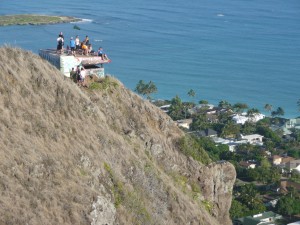The Ka’iwa Ridge Trail, also known as the Lanikai Pillbox Trail, consists of 4.073 acres located on Tax Map Key: [1] 4-2-02: Parcel 17 and is owned by the Department of Land and Natural Resources as part of the State’s Na Ala Hele Trail System. The beautiful panoramic views and accessibility of the trail make it a very popular hike.
The structures at the top of the ridge, which are commonly and mistakenly referred to as the “Lanikai Pillboxes”, functioned as Coast Artillery observation stations in 1943 and were not equipped with defensive armament. The raised concrete platforms found in the stations did not mount machine guns but high-powered observing instruments to fix a maritime vessel’s position from the station. In military terms, a pillbox actually means a defensive site such as a machine gun pillbox, which is not the case here.
Sometime after WWII, the military sold the ridge to a private individual, and then it was subsequently resold one or perhaps two more times to private individuals until the late 1980’s. The last private owner submitted plans to build a house on the site and drill a hole through the rocks to provide ventilation for the house. Around this time the State was promoting it’s Na Ala Hele trail system, and the Lanikai Association proposed the State buy the property, since it was an historic site and was already a well-publicized trail. The State then incorporated the trail into their trail system with two public easements to the top.
There have been several other trails made to the top over the years, but these all cross over private property which have no public easements. The descents onto Luika Place and Koohoo Place are on private property, and they are creating erosion issues with soil going into the ocean and smothering the coral, as well as trespassing concerns. With the influx of so many hikers, the landowners have now put up “no trespassing” signs and are having the police enforce them.
To find out more about Lanikai, read the book “Kailua” by the Kailua Historical Society.